Crystal Rose Cow Dog College
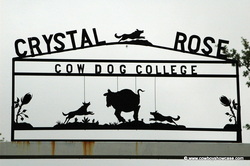
Sandi and Merle Newton’s passion is Border Collie dogs. The Newtons breed, train, show, and sell Border Collies. They also help other dog owners with their dog training and associated problems. They run the Crystal Rose Dog College on their ranch located 18 miles west of Red Bluff, California.
During the month of March 2005, we were invited by the Newtons to attend a working cow-dog clinic and field trial at their ranch. This ranch complex is located in the rolling hills of Tehama County in northern California. The country surrounding the ranch is composed of open savannahs with live oak trees, pines, and green grass. Red Bank Creek runs through the property providing live water. There is a camping area set up for customers and contestants staying overnight with their dogs and horses. A converted hay shed is used as a covered meeting and cooking area. The covered area works well if it rains, which it definitely did while we were there. The corral setup is very well constructed, with sorting alleys, a squeeze chute, and an arena with a good sand base that provided solid footing for dogs and horses. A portable announcer’s stand, to be used for judges, and timers, was set near the arena. We were met by the camp cook, Gene Gardner, a real western campfire cook, who had brought his portable cook wagon and commissary from Redding, California to provide meals for the week of events. The cooking equipment looked very professional and, as we soon found out, his cooking skills matched his equipment. We went looking for Merle and Sandi and found them on the ranch with their horses and dogs. We sat down with them in their home and visited about how they got started in the stock dog business. We found out that Merle had spent his childhood in Oklahoma and had been exposed to stock dogs and cattle at a very early age. Merle said, ”My dad ran wheat pasture cattle and at that time the country was unfenced and open. When I came home from school in the afternoon my job was to catch and saddle my horse, gather up my dogs and go find the cattle that had strayed off our place and bring them home.” This early exposure to cattle and stock dogs made a lasting impression upon Merle. Sandi, Merle’s wife, grew up in Shasta County, California and was exposed to cattle, horses, and dogs on area ranches at an early age. Merle moved from Oklahoma after high school, met Sandi and they got married. The couple began to work and manage cow ranches in northern California. They soon became very proficient in using stock dogs to work cattle in the sometimes brushy and steep terrain. Word spread that these folks knew what they were doing when it came to handling stock with dogs. Ranchers from the surrounding area began to call and ask the Newtons to come bring their dogs and assist them in getting in “hard to gather cattle.” Sandi and Merle began to get serious about the dog business and began to breed and train cow dogs for sale. Sandi had a female Border Collie named “Rosey.” This dog was a super-strong cow dog with a lot of natural instinct and ability to work a cow. This female dog launched the Newtons into the cow-dog sales world. The bloodlines of the dogs they use today still go back to “Rosey.” 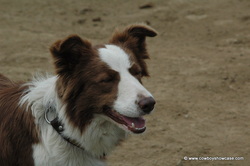
Border Collies:
I asked Merle and Sandi, “ Why is it the only breed of dogs I have seen on your ranch so far are Border Collies? Merle replied, ” Border Collies are the best breed for what we are doing. They have risen to the top within the cow dog breeds in the past 20 years. They come in all shapes, colors, and sizes but they are still Border Collies. Before this time everyone thought a Border Collie was just a sheep dog.” I asked Merle why it is that Border Collies rose to the top. Merle said, ”I can answer that question with one word, ‘HEART.’” He elaborated saying, “Border Collies are silent which makes them good to use around cows and calves. They use eye contact and body language to control livestock. They will work with you, not against you. They are very trainable, smart, and want to please. These dogs can take a lot of training pressure and still maintain their composure. When the sheep numbers in California began to decline, the Border Collie dogs that were too ”rough” on sheep began to show up on cow outfits. At that time, the thinking of cowmen in general was: if I own a Border Collie, this dog needs to be rough and have a “bite” to work cattle. Then a man by the name of Ray Hunt started doing horse clinics throughout California. He taught people about pressure and release with horses. We attended several of Ray’s clinics and began to apply Hunt’s principals to dog training. Soon a new look in Border Collies began to appear. These dogs began to control cattle, move cattle, and sort cattle by using body language and eye contact that was much more refined than the old way of a dog’s charging into the herd, scattering cattle every direction and taking hold of the nose on a cow. Dogs began to learn the “flight zone” of cattle. To better define this term, picture a group of cattle with a large bubble over them. When your dog enters this bubble, the cows will either move on or fight your dog. We soon learned that flight zone of cattle is much different than the flight zone of sheep. Cattle need to be worked further away with the dog than sheep. We began to work the dogs to get them to move in and out of this “flight zone” (bubble), which became pressure and release on the cattle. We began to see that the way a dog presented himself to a cow was a major factor in successful stock handling with dogs. As Ray Hunt would say, ‘Set it up and let it happen.’” Sandi added her thoughts to our conversation. She said, “One nice part about using Border Collies to help with cow work on your ranch is they can replace two or three average hands, they don’t go to town on the weekend and forget to come back to the ranch on Monday, and they don’t know about workman’s comp!” Starting Pups: I asked Merle and Sandi, “How do you start your cow dog pups?” Merle gave this insight into starting pups. “ We do hands-on pup starting. We do not use electronic dog collars. We begin to develop a bond with our pups soon after they are born. We want to become the “Alpha Dog” in their life, the leader of their dog pack. We start out by going into the dog’s world. We begin to “growl” at the pups with our voice and establish eye contact. We need to gain their respect right from the start. Give them a kind word when they do well. We begin to get a “handle” on the pup. We teach commands such as ‘Down/lay down,’ ‘that’ll do,’ ‘wait,’ etc. Then we start the pups on sheep. Again, we are using the pack mentality. We are training the dog to bring the ‘food’ to us, as we are the alpha dog of the pack. We want them to first bring the sheep back to us.” “For a pup to be trainable, there must be four factors present for success.1. Instinct 2. Be able to withstand training pressure 3. Accept the human as the alpha dog 4. Must be able to stand their ground against livestock If a pup lacks one or more of these factors, there is a good chance they will wash out of our training program.” “As you start your dog on cows, do not overmatch the dog with “bronco” cattle. The dog needs to build up confidence around livestock and it will do the dog no good to be run over by a wild cow the first day of training.” 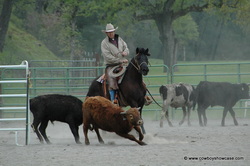
Buying a Dog
I asked Merle, “If I buy a broke dog from you and take the dog to my ranch can I expect to work cows with this dog the next day?” Merle replied to this question by saying, “You first must bond with this dog and they need to begin to trust you. If we, as the dog’s trainers, are removed from where the dog is taken, it will be much easier for the dog to make the switch from us to you, We will monitor the dog’s progress by phone and help the buyer with questions and problems that may come up. Many times we must train the owner in how to work the dog and that is one reason for the Cow Dog College.” So, the next question I asked was, “How much money would a broke cow dog cost?” Merle responded by saying, “It would depend on the dog, sex, age, etc. Broke cow dogs can go as high as $10,000 in Red Bluff at the stock-dog sale. We would need to look at your specific needs and fit the dog and price to you.” I asked, ”How long can I expect to use this dog on a cow outfit? Merle replied, ”Barring injury, which can happen when you use a dog around livestock, a dog at two years of age can be ready to work cattle outside and they should go strong until they are eight or nine years old. The typical life span of a Border Collie is about twelve years.” 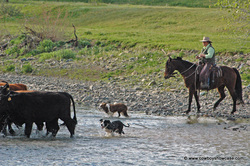
Horses:
The field trials we were going to see at Crystal Rose are set up to represent in a realistic way how people work their cattle while riding horseback and working their dogs. The events feature four elements: humans, cattle, horses, and dogs. Horses play a big part. I asked Merle and Sandy what they would look for in a horse for these events. Sandi replied, “We both ride Fox-Trotter Horses. They are very smooth riding and sure cover the country. We get along great with them, they are easy to handle around cattle, and they are not bad to kick at our dogs.” “If you are a beginner just starting out in the stock dog world and have not been around a lot of cattle and dogs, look for an older horse, preferably one that has been around cattle and dogs and rides quiet. If you have to constantly be working with your horse and you are new to dogs and cattle, it compounds your problems to ride an unbroken horse. I always tell people that if you are new to this game, become comfortable with your horse first before you try and work cattle with your dog,” “Expose your pup to horses at an early age. Remember when you place your horse in the training equation you are adding another factor; these pups are trained to take after something that is moving. “ 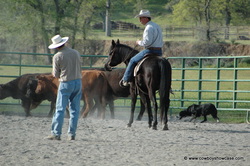
The Clinic:
David Hutchins, a stockman and dog handler, who has won several National Stock Dog Trail Championships in New Zealand, was on hand at the Crystal Rose to hold a four-day clinic for people using their dogs and horses. We arrived on the last day of the clinic. We watched David work with his students, their horses, and their dogs in the arena. They worked on letting the dogs drive cattle. David explained, “Cattle are prey animals that want to flee from your dog. If your dog blocks the front end of the cattle by going ahead of the shoulder, the cattle will scatter out and you will loose control of the herd. How you handle your dog and horse when working cattle can have a great effect on how the cattle handle.” David stressed, “Do not work the lead; always work behind the shoulder on cattle and in the rear.” He would have the students place their dog behind the shoulder of the cattle and push. The clinic student would bring up the rear, horseback. Then he had the student and the dog trade places. This positioning of the dog and horse allowed the cattle to move forward. David stressed that the cattle need to move forward in a straight line. If the dog or the man horseback went by the shoulder on the cattle, they would scatter or stop and fight the dog. He also stressed to the students, “Do not take your eye off the cattle.” David summed up his clinic by saying to us, “ People know a lot about dog training, but do not know much about dogs. I am trying to teach people to learn more about their dogs and let the dog’s natural ability come out, rather than over training their dog.” 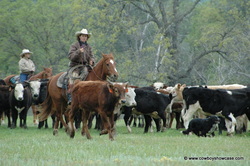
Rodear:
A brand new cow-dog/cattle trial event was initiated at this get together. Ambrose McAuliffe, from Fort Klamath, Oregon trucked a load of Mexican Corriente steers to Crystal Rose to be used for this event. Ambrose is a legend in northern California and southern Oregon. This man has been around cattle and dogs all his life and has handled thousands of cattle in his lifetime. Ambrose hosts several major “cuttings” at his ranch in Oregon each summer. He furnishes the Corriente cattle for these cuttings. Along with the cuttings, he plans on holding what he calls a “Rodear” competition for stock dogs. Ambrose’s goal with his livestock is to breed and provide cattle and horses especially suited for recreational uses such as cutting, roping, or cow dog trials. The rules for this rodear event are very simple and direct: Ride into a pen full of Corriente cattle; cut three head of cattle with the same colored ear tag out of the herd with help from your dog and horse; take these cattle through an open gate in the middle of several panels set up in the arena; continue on to a holding pen outside the main arena and corral them. This trial is judged for points and time. Ambrose is a romantic at heart and wants to see the old west survive. He is encouraging people who have never been around horses, cattle, and dogs to come see how this works. Ambrose contact information: phone #541 381 2294, address General Delivery PO box 456, Fort Klamath OR 97626 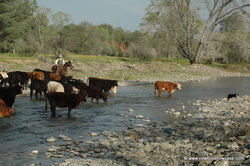
The Main Event – Ranch Dog Trials (Open)
Hosted by: Merle and Sandi Newton, Crystal Rose Cow Dog College and Bill and Sandy Renihan, Indian Oaks Ranch The last two days of the Crystal Rose Cow College week of activities were the Open Ranch Dog Trails. Seventeen contestants entered the two-day event. Many cow dog competitions are held in buildings, small arenas, or fields, but this event was held on a cross-county course covering about a mile through fields, streams, and trees. The Newtons are striving with events of this kind to “push the envelope” to see how far Border Collies can go in handling cattle outside. This event consisted of the following scenario: Course description for the ranch dog trial held March 19th and 20th "I gathered my cattle the other day, and it has come to my attention that three of them are yours. Bring your best dog and saddle horse to get them because it will be a long and challenging trip back to the home ranch. You will find them in the alleyway next to a corral full of other cattle. You will take them from the alley through an arena and out into an open field. On the way across the open field you will need to stop and rest your cattle in a designated area. Upon leaving the rest area you will go out of the open field through a gate into a creek bottom. There you will need to stop your cattle and give them the opportunity to drink. You will continue up a steep hill and through another gate. The drive will continue across a treed flat at the foot of a brushy hill. Another rest will be required, this time in a holding pen along the way. While resting your cattle in the holding pen you will hear a cowbell in the distance. Suspecting it might be attached to one of your other missing cows, you will send your dog to get them to add to your cattle in the pen. Now with 5 head you will continue on your way. Your cattle will need to be fed on this long trip. Seeing a haystack up ahead you will stop your horse and have your dog drive them to the hay. Once they are settled on the hay you will ride on ahead to check the creek crossing. Once you have ridden across the creek and determined it is ok for the cattle to cross, you will send your dog back to get the cattle. Once across the creek you will be in the home pasture. You will go to the corral and sort off the 2 strays you picked up along the way." The American Cow Dog Bill Renihan, Indian Oaks Ranch cow dog enthusiast, who assisted Merle Newton in hosting this weeklong event, had this to say about cow dogs, ”We have the American cowboy, the American Quarter horse and now we need to recognize we have the ‘American cow dog’.” The USBCHA, United States Border Collie Handler’s Association, west-coast director John Doyle from San Diego, California, said, “Cow dogs are a brand-new concept in California and Oregon. These cow dog trials are a unique American event. The USBCHA had always been a sheepdog organization. Only in the last couple of years have cow dogs been invited to join.” After watching these folks work their dogs and horses and the camaraderie that was evident between contestants, guests, and volunteers, I am sure what they say is true. This event is truly made in America. Contact Information
The Newtons are available for clinics at your ranch or training facility using your livestock or livestock provided by Crystal Rose. For those without a facility, or the ability to arrange for one, the Newton's are also able to host a clinic for a private group at Crystal Rose. The focus of each Crystal Rose clinic is tailored to suit individual needs and can cover anything from beginner workshops, to starting puppies, to advanced livestock handling. Sandi Newton sums up their philosophy by saying, “We are here for the Border Collie.” Crystal Rose offers a limited number of started and finished dogs for sale each year; and, on occasion, puppies from selective, working cattle dog focused breeding. Contact Crystal Rose
Crystal Rose Cow Dog College www.cowdogcollege.com Merle and Sandi Newton 14200 Red Bank Road Red Bluff, CA 96080 Telephone - (530) 529-3700 Facsimile - (530) 529-4700 E-Mail: [email protected] or [email protected] Article by Mike Laughlin [email protected] Photos by Lee Raine |
|
